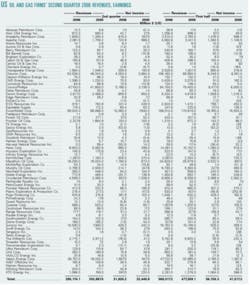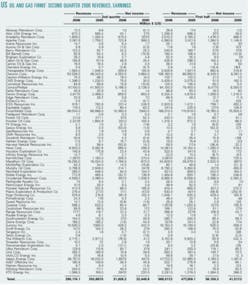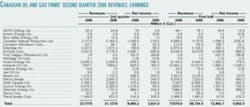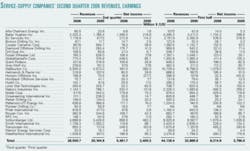US oil and gas companies posted solid earnings gains for the second quarter and first half of 2006, while samples of Canadian firms and service and supply companies recorded even bigger year-on-year gains.
Prices for crude oil and products remained strong during the second quarter, and production volumes were higher for many oil and gas producers. Natural gas prices, though, moved lower in the second quarter from the first 3 months of 2006 and were little changed from a year earlier.
US producers
Strong price realizations for crude along with higher production volumes bolstered earnings in the first half and second quarter.
The spot price of West Texas Intermediate crude in the quarter ended June 30 averaged $70.41/bbl, up 33% from the same year-earlier quarter. For the first half of 2006, WTI spot prices averaged 30% higher than they did in the same 2005 period.
ExxonMobil Corp., which reported a 36% earnings increase to $10.36 billion for the second quarter, credits higher oil and gas price realizations for the gain. Lower marketing margins, though, partially offset the higher prices and refining margins. Also, the company’s second-quarter worldwide production of oil, gas, and natural gas liquids climbed.
A sample of US-based oil and gas producers and refiners posted a combined 17% gain in revenue and 38% higher earnings for the second quarter as compared with the same year-earlier period. For the first half of 2006, these same companies reported a 35% climb in net income.
Some firms posted declines in second-quarter 2006 net income, including Occidental Petroleum Corp. and Murphy Oil Corp.
Second-quarter earnings for Occidental declined to $857 million from $1.536 billion despite increases in production volumes and crude prices. The company reported that during the second quarter of 2005, it incurred a $619 million tax benefit from a closing agreement with the US Internal Revenue Service and a $140 million pretax gain from the sale of 11 million shares of Lyondell Chemical Co.
On May 15, 2006, Ecuador’s energy minister terminated Occidental’s contract for the operation of Block 15, and the government of Ecuador seized Occidental’s Block 15 assets shortly thereafter. As a result of the seizure, Occidental classified its Block 15 operations as discontinued operations.
Murphy Oil reported that its decline in net income for the second quarter was primarily related to a gain in the 2005 second quarter of $106.8 million on the sale of mature oil and gas properties in the Gulf of Mexico and losses in its refining and marketing business in 2006, caused by downtime and unrecoverable repair costs at its Meraux, La., refinery following Hurricane Katrina.
Refining results
Murphy Oil’s refining and marketing operations lost $13.2 million in the 2006 second quarter vs. a profit of $67.4 million a year earlier. The Meraux refinery was down for repairs following Hurricane Katrina for a portion of the 2006 quarter before restarting in May. Murphy incurred $26.5 million in unrecoverable Hurricane Katrina-related repair costs at the refinery.
Refining margins spiked following Hurricane Katrina. Although they moderated in the first quarter of 2006, refining margins climbed again on strong demand in the second quarter, according to Muse, Stancil & Co.
The US Gulf Coast refining margin increased 69% from a year earlier to average $18.39/bbl in the second quarter. Meanwhile, the US West Coast margin also swelled, averaging $36.77/bbl in the recent quarter vs. $15.71/bbl a year earlier.
Pump prices rose 30% from a year earlier during the second quarter not only due to strong demand but also because of a switch to summer-grade fuel and a requirement to increase use of ethanol as an additive.
“Gasoline refiners and blenders moved to replace MTBE with ethanol much more quickly than most people expected, in our view, creating an octane shortage and causing ethanol prices to spike,” said Friedman, Billings, Ramsey & Co. Inc. analyst Jacques Rousseau.
Using Department of Energy production and inventory data, Rousseau calculates that US fuel ethanol consumption averaged a record 6.2 billion gal/year annualized during June. With US ethanol production up in June, domestic production was still below demand, necessitating a substantial increase in imports and a drawdown on inventories.
“While US ethanol production capacity continues to grow, we believe it will take several more months for supply and demand to arrive at a more normalized balance. In the meantime, we expect ethanol prices to remain high,” Rousseau said.
The impact of high ethanol prices on large refiners should be limited, though, given that ethanol still accounts for a small percentage of the US gasoline market.
The refiners in the OGJ sample of companies recorded big earnings gains for the second quarter and for the first half of 2006. Valero Energy Corp., for example, reported that its second-quarter net income increased 126% from a year ago, while its first-half earnings grew 99%.
Canadian companies
Surges in net income by a few of the firms in a sample of Canadian companies resulted in a 130% increase in collective earnings for the second quarter. For the first 6 months of 2006, all of the companies in the sample posted a combined 147% gain in net income.
Canadian Natural Resources Ltd., EnCana Corp., and Suncor Energy Inc. recorded much higher second-quarter earnings for various reasons, including increased oil sands production and prices.
With a 374% gain in earnings for the second quarter, Canadian Natural Resources reported that its production volumes were up 10% from a year earlier. Crude oil volumes increased 17% from year-earlier levels as a result of increased production from heavy crude oil operations at Primrose and Pelican Lake.
Also, Canadian Natural Resources’ earnings included a benefit of $438 million (Can.) for the effect of statutory income tax rate changes in Canada on future income tax liabilities.
EnCana reported that its robust cash flow and earnings during the second quarter were due to higher prices for heavy oil and increased natural gas sales, which benefited from favorable gas price hedges. EnCana’s gas sales were up 5% from a year earlier.
Suncor Energy recorded second-quarter earnings of $1.2 billion (Can.), compared with $83 million a year earlier. This increase was mostly due to higher oil sands production, strong commodity prices, and lower income taxes due to lower federal and Alberta provincial income tax rates.
Suncor’s total upstream production averaged 302,400 boe/d during the second quarter of this year, compared with 160,600 boe/d in the second quarter of 2005. Oil sands production during the recent quarter averaged 267,300 b/d. This consisted of 258,800 b/d of synthetic crude oil and 8,500 b/d of bitumen. Natural gas production climbed 8%.
During the second quarter of this year, oil sands cash operating costs for Suncor averaged $18.30/bbl, compared with $27.10/bbl during the second quarter of 2005. The decrease in cash operating costs per barrel is due to operating expenses being spread over more barrels of production, Suncor reported.
Service, supply firms
In a sample of 31 service and supply companies, none reported a loss for the second quarter, and only three reported declines in earnings. The average worldwide rig count in the quarter was up 13% from a year earlier and up 28% from 2 years earlier, according to Baker Hughes Inc.
Horizon Offshore Inc. turned around a second quarter 2005 loss and posted net income of $16.9 million in the recent quarter. The company said the earnings are primarily due to its US and Latin America operations. Demand for construction services in the US Gulf of Mexico remained strong during the recent quarter, driving increased prices for offshore construction contracts and high vessel utilization.
The combined revenues of the sample increased 32% in the 2006 second quarter vs. the same 2005 period, and net income surged 128%. For the first half of this year, results were up only slightly less.




